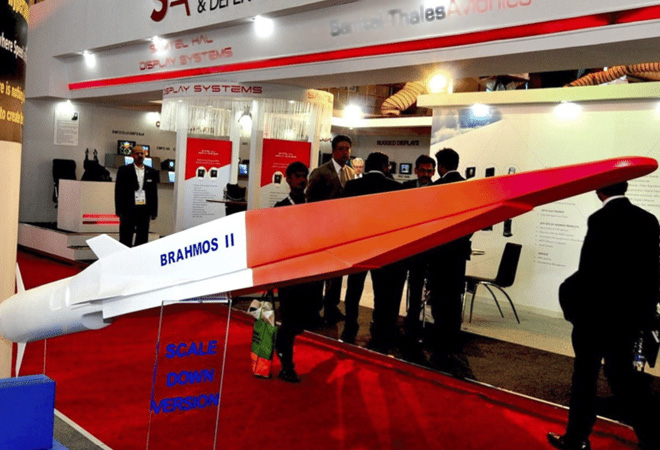
Amidst Russia’s deployment of the MiG-31 fighter aircraft armed with hypersonic Kinzhal missiles to its Kaliningrad region, the threat of American sanctions targeting India-Russia military-technical cooperation remains omnipresent, including in the area of co-development of hypersonic missiles.
With a maximum range of 2,000-km and Mach 10 speed, Kinzhal missiles certainly make for a fearsome combination. The Russian move, therefore, appears to be aimed at showcasing the ability to endanger North Atlantic Treaty Organization’s (NATO) assets, given that the Russian semi-exclave of Kaliningrad borders NATO members, Poland and Lithuania.
With an increasingly belligerent China, already having demonstrated its hypersonic capabilities during its recent military drills near Taiwan, and the distinct possibility of the technologies’ proliferation to ‘Iron brother’ Pakistan, India too finds it necessary to develop a hypersonic successor to its BrahMos supersonic cruise missile co-developed with Russia. As correctly articulated by the Defence Minister Rajnath Singh, this is needed to maintain minimum credible deterrence against enemies.
Being a signatory to the Missile Technology Control Regime (MTCR), India is allowed to develop missiles with ranges over 300 km and weighing more than 500 kg, but cannot provide the same to third parties.
In a recent conversation with a Russian news agency, the CEO of the BrahMos missile original equipment manufacturer alluded to the possibility of the hypersonic BrahMos cruise missile, the BrahMos-II, having the same specifications as the hypersonic variant of Russia’s Tsirkon missile, and expects five or six years to elapse before flight trials commence. In his words, “The whole world is working on hypersonics. I have not seen anyone in the world having hypersonic cruise missiles. (But) Russia says it tested the Tsirkon.”
The CEO stated that the BrahMos-II shall not be exported, but will be manufactured only for Russia and India. This is because being a signatory to the Missile Technology Control Regime (MTCR), India is allowed to develop missiles with ranges over 300 km and weighing more than 500 kg, but cannot provide the same to third parties.
The BrahMos Success
The BrahMos cruise missile is the result of years of collaboration and investment between Russia and India, and is a key example of how intimately linked Moscow’s and New Delhi’s defence industries are. Although the missile is yet to feature in actual combat, inferences based on various test results indicate its formidability.
Also called the PJ-10, the BrahMos has turned into a beacon of hope for the Indian defence industry. Russia’s contribution to the manufacturing has largely been restricted to the supply of numerous components.
The basic version of the PJ-10 has an estimated range of 300-500 km, with the export version’s range capped at 290 km in compliance with the MTCR.
The India-Russia joint venture producing the missile system was set up in 1998, following which development commenced. BrahMos was initially inducted into the Indian Navy in 2005, following its test-firing in 2001. The missile was subsequently inducted into the Indian Army and the Indian Air Force, with the latter having integrated the missile with its Russian-origin Sukhoi Su-30MKI fighter aircraft.
The BrahMos seems to be an advancement of the Russian P-800 Oniks cruise missile. The basic version of the PJ-10 has an estimated range of 300-500 km, with the export version’s range capped at 290 km in compliance with the MTCR. The Brahmos can be launched from sea, air, or land and can carry conventional or nuclear payloads.
The Philippines became the first export destination for the BrahMos missile, under a US $368 million contract between Manila and New Delhi signed in January 2022. Vietnam has also considered purchasing the missile system for defending itself against Chinese intrusions in its exclusive economic zone in the South China Sea, although an actual purchase is yet to fructify. Thailand, Singapore, and Malaysia are also interested in the missile system.
India, at the same time, is pursuing the Hypersonic Technology Demonstrator Vehicle (HSTDV) programme as a hedge against the possibility of American sanctions on India-Russia missile cooperation.
Way Forward
If the BrahMos–II programme fructifies, it shall demonstrate the resilience of Russia’s defence industry as well as India’s determination to maintain strategic autonomy as a key feature of its foreign policy. Serving as Chairman of the Senate Armed Services Committee, the United States’ Senator Jack Reed, in fact ,admitted that “We (United States) used to dominate technology. That’s no longer the case. (In) hypersonic, clearly, China and India, Russia have advantages on it”.
India, at the same time, is pursuing the Hypersonic Technology Demonstrator Vehicle (HSTDV) programme as a hedge against the possibility of American sanctions on India-Russia missile cooperation. The homegrown HSTDV program is, therefore, funded and researched separately from BrahMos–II. Despite the risk, however, it is likely that the demonstrated and well-substantiated virtues of India-Russia relations will be more realistic for India to further its hypersonic munitions ambitions.
The views expressed above belong to the author(s). ORF research and analyses now available on Telegram! Click here to access our curated content — blogs, longforms and interviews.




 PREV
PREV


